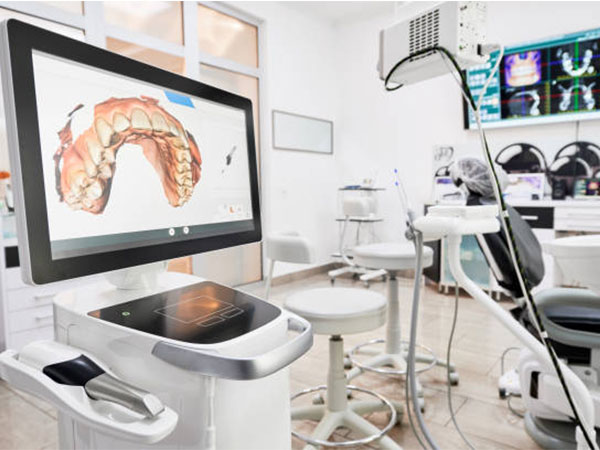Step into a world where your smile meets the future! Our guide, “Innovations in Dental Implant Technology: Latest Trends,” is your ticket to the cutting edge of oral health.
We’re demystifying the latest trends, from 3D bioprinting to clever smart implants, that are changing the game in dental care. Get ready to explore, absorb knowledge, and ride the wave of innovation that’s creating a new norm for dazzling smiles.
Let’s explore the latest dental implant technology together like never before!
5 Latest Innovations in Dental Implant Technology
In recent years, the field of dental implant technology has witnessed remarkable advancements, offering patients more efficient and sophisticated solutions for restoring their smiles.
Explore the cutting-edge innovations shaping the future of dental implants and providing enhanced experiences for those seeking optimal oral health.
1. 3D Bioprinting:
One of the groundbreaking technologies in dental implantology is 3D bioprinting. This technique goes beyond traditional methods, allowing for the creation of customized implants with incredible precision.
By leveraging this technology, dental professionals can tailor implants to match the unique contours of each patient’s mouth. So they ensure a snug fit and optimal functionality. This not only enhances the aesthetics of the implant but also contributes to a more comfortable and natural feel.
2. Nanotechnology:
Regarding the microscopic field, nanotechnology has emerged as a game-changer in Dental Implant innovations. Nanomaterials exhibit extraordinary strength and biocompatibility, reducing the risk of complications and improving the overall performance of dental implants.
This innovative approach not only enhances the durability of the implants but also promotes faster healing, making the entire implant process more efficient for patients.
3. Bioactive Glasses:
The introduction of bioactive glasses marks a significant stride in dental implant innovation. These glasses, when used in implants, interact with the surrounding tissues to stimulate bone regeneration actively.
Unlike traditional materials, bioactive glasses encourage the integration of natural bone, promoting a more robust and enduring foundation for dental implants. Patients benefit not only from the aesthetic improvement but also from accelerated healing processes, making the journey toward a restored smile faster and more comfortable.
4. Dental Cone Beam Computed Tomography (CBCT):
Dental Cone Beam CT (CBCT) is revolutionizing the way dentists plan and execute implant procedures. This technology provides a three-dimensional view of the oral structures, offering unparalleled precision in implant placement.
With CBCT, dentists can visualize the patient’s anatomy from various angles to ensure optimal positioning of implants and minimize the risk of complications. This innovative approach not only enhances the success rates of implant surgeries but also contributes to a more efficient and patient-friendly experience.
5. Innovative Implants with Inbuilt Sensors:
Incorporating the principles of smart technology, dental implants with inbuilt sensors represent the future of oral healthcare. These implants are equipped with sensors that monitor various aspects of oral health, such as pressure, temperature, and pH levels.
The real-time data collected by these sensors enables proactive and personalized care, allowing for early detection of potential issues and timely interventions. Patients can enjoy not only the functional benefits of these implants but also the assurance of continuous monitoring for long-term oral well-being.
FAQs
- What are the new trends in dental implants?
In dental implants, the latest trends focus on faster healing, minimally invasive procedures, and advancements in materials for a more natural look and feel.
- What is the new technique of tooth implants?
The latest tooth implant technique involves using cutting-edge methods like computer-guided surgery and 3D imaging for precise placement, ensuring a more comfortable experience and better results.
- Name of the latest material for implants? (Biomimetic material)
The newest material for dental implants is biomimetic material. This advanced substance closely mimics natural teeth, providing a more lifelike appearance and enhancing overall durability.
- What are smart dental implants?
Smart dental implants are innovative devices equipped with technology to monitor and adapt to your mouth’s conditions. They can optimize healing and offer real-time data for improved long-term oral health.
- Which type of dental implants are best?
The best type of dental implant depends on individual needs. However, titanium implants remain a popular choice due to their durability and compatibility with the body. Always consult with your dentist to determine the most suitable option for you.
Conclusion
As we navigate the dynamic landscape of dental implant technology, these innovations bring a sense of excitement and possibility. From 3D bioprinting to smart implants, the future of dental care looks promising. Stay curious, stay informed, and anticipate a future where your smile benefits from the latest breakthroughs in oral health.
We hope this article has shed light on the queries you may have had about dental implants. Remember, a well-informed choice is the first step towards a healthier smile. If you still have questions or concerns, don’t hesitate to consult with Premier Choice Dental Center for personalized advice.


